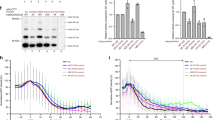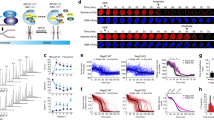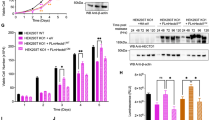Abstract
Polo-like kinase 1 (PLK1) critically regulates mitosis through its dynamic localization to kinetochores, centrosomes and the midzone. The polo-box domain (PBD) and activity of PLK1 mediate its recruitment to mitotic structures, but the mechanisms regulating PLK1 dynamics remain poorly understood. Here, we identify PLK1 as a target of the cullin 3 (CUL3)-based E3 ubiquitin ligase, containing the BTB adaptor KLHL22, which regulates chromosome alignment and PLK1 kinetochore localization but not PLK1 stability. In the absence of KLHL22, PLK1 accumulates on kinetochores, resulting in activation of the spindle assembly checkpoint (SAC). CUL3–KLHL22 ubiquitylates Lys 492, located within the PBD, leading to PLK1 dissociation from kinetochore phosphoreceptors. Expression of a non-ubiquitylatable PLK1-K492R mutant phenocopies inactivation of CUL3–KLHL22. KLHL22 associates with the mitotic spindle and its interaction with PLK1 increases on chromosome bi-orientation. Our data suggest that CUL3–KLHL22-mediated ubiquitylation signals degradation-independent removal of PLK1 from kinetochores and SAC satisfaction, which are required for faithful mitosis.
This is a preview of subscription content, access via your institution
Access options
Subscribe to this journal
Receive 12 print issues and online access
$209.00 per year
only $17.42 per issue
Buy this article
- Purchase on Springer Link
- Instant access to full article PDF
Prices may be subject to local taxes which are calculated during checkout






Similar content being viewed by others
Change history
12 March 2013
In the version of this Article that was originally published, the acknowledgement to S. Elowe was omitted in error.
References
Williams, B. R. & Amon, A. Aneuploidy: cancer’s fatal flaw? Cancer Res. 69, 5289–5291 (2009).
Lengauer, C., Kinzler, K. W. & Vogelstein, B. Genetic instabilities in human cancers. Nature 396, 643–649 (1998).
Strebhardt, K. Multifaceted polo-like kinases: drug targets and antitargets for cancer therapy. Nat. Rev. Drug Discov. 9, 643–660 (2010).
Petronczki, M., Lenart, P. & Peters, J. M. Polo on the rise-from mitotic entry to cytokinesis with Plk1. Dev. Cell 14, 646–659 (2008).
Sumara, I. et al. Roles of polo-like kinase 1 in the assembly of functional mitotic spindles. Curr. Biol. 14, 1712–1722 (2004).
Lenart, P. et al. The small-molecule inhibitor BI 2536 reveals novel insights into mitotic roles of polo-like kinase 1. Curr. Biol. 17, 304–315 (2007).
Elowe, S., Hummer, S., Uldschmid, A., Li, X. & Nigg, E. A. Tension-sensitive Plk1 phosphorylation on BubR1 regulates the stability of kinetochore microtubule interactions. Genes Dev. 21, 2205–2219 (2007).
Maia, A. R. et al. Cdk1 and Plk1 mediate a CLASP2 phospho-switch that stabilizes kinetochore–microtubule attachments. J. Cell Biol. 199, 285–301 (2012).
Liu, D., Davydenko, O. & Lampson, M. A. Polo-like kinase-1 regulates kinetochore–microtubule dynamics and spindle checkpoint silencing. J. Cell Biol. 198, 491–499 (2012).
Lee, K. S. et al. Mechanisms of mammalian polo-like kinase 1 (Plk1) localization: self- versus non-self-priming. Cell Cycle 7, 141–145 (2008).
Elia, A. E. et al. The molecular basis for phosphodependent substrate targeting and regulation of Plks by the Polo-box domain. Cell 115, 83–95 (2003).
Cheng, K. Y., Lowe, E. D., Sinclair, J., Nigg, E. A. & Johnson, L. N. The crystal structure of the human polo-like kinase-1 polo box domain and its phospho-peptide complex. EMBO J. 22, 5757–5768 (2003).
Hanisch, A., Wehner, A., Nigg, E. A. & Sillje, H. H. Different Plk1 functions show distinct dependencies on Polo-Box domain-mediated targeting. Mol. Biol. Cell 17, 448–459 (2006).
Nigg, E. A. Mitotic kinases as regulators of cell division and its checkpoints. Nat. Rev. Mol. Cell Biol. 2, 21–32 (2001).
Mateo, F., Vidal-Laliena, M., Pujol, M. J. & Bachs, O. Acetylation of cyclin A: a new cell cycle regulatory mechanism. Biochem. Soc. Trans. 38, 83–86 (2010).
Hershko, A. The ubiquitin system for protein degradation and some of its roles in the control of the cell division cycle. Cell Death Differ. 12, 1191–1197 (2005).
Li, W. & Ye, Y. Polyubiquitin chains: functions, structures, and mechanisms. Cell. Mol. Life Sci. 65, 2397–2406 (2008).
Deshaies, R. J. SCF and cullin/ring H2-based ubiquitin ligases. Annu. Rev. Cell Dev. Biol. 15, 435–467 (1999).
Petroski, M. D. & Deshaies, R. J. Function and regulation of cullin-RING ubiquitin ligases. Nat. Rev. Mol. Cell Biol. 6, 9–20 (2005).
Sumara, I., Maerki, S. & Peter, M. E3 ubiquitin ligases and mitosis: embracing the complexity. Trends Cell Biol. 18, 84–94 (2008).
Sumara, I. et al. A Cul3-based E3 ligase removes Aurora B from mitotic chromosomes, regulating mitotic progression and completion of cytokinesis in human cells. Dev. Cell 12, 887–900 (2007).
Maerki, S. et al. The Cul3-KLHL21 E3 ubiquitin ligase targets aurora B to midzone microtubules in anaphase and is required for cytokinesis. J. Cell Biol. 187, 791–800 (2009).
Li, Y. & Benezra, R. Identification of a human mitotic checkpoint gene: hsMAD2. Science 274, 246–248 (1996).
Sumara, I. & Peter, M. A Cul3-based E3 ligase regulates mitosis and is required to maintain the spindle assembly checkpoint in human cells. Cell Cycle 6, 3004–3010 (2007).
Matsumura, S., Toyoshima, F. & Nishida, E. Polo-like kinase 1 facilitates chromosome alignment during prometaphase through BubR1. J. Biol. Chem. 282, 15217–15227 (2007).
Joseph, J., Liu, S. T., Jablonski, S. A., Yen, T. J. & Dasso, M. The RanGAP1-RanBP2 complex is essential for microtubule-kinetochore interactions in vivo. Curr. Biol. 14, 611–617 (2004).
Kim, W. et al. Systematic and quantitative assessment of the ubiquitin-modified proteome. Mol. Cell 44, 325–340 (2011).
Wagner, S. A. et al. A proteome-wide, quantitative survey of in vivo ubiquitylation sites reveals widespread regulatory roles. Mol. Cell Proteomics 10, 013284 (2011).
Park, J. E. et al. Polo-box domain: a versatile mediator of polo-like kinase function. Cell Mol. Life Sci. 67, 1957–1970 (2010).
Moghe, S. et al. The CUL3-KLHL18 ligase regulates mitotic entry and ubiquitylates Aurora-A. Biol. Open 1, 82–91 (2012).
Pintard, L., Willems, A. & Peter, M. Cullin-based ubiquitin ligases: Cul3-BTB complexes join the family. EMBO J. 23, 1681–1687 (2004).
Villeneuve, N. F., Lau, A. & Zhang, D. D. Regulation of the Nrf2-Keap1 antioxidant response by the ubiquitin proteasome system: an insight into cullin-ring ubiquitin ligases. Antioxid. Redox. Signal 13, 1699–1712 (2010).
Huotari, J. et al. Cullin-3 regulates late endosome maturation. Proc. Natl Acad. Sci. USA 109, 823–828 (2012).
Boyden, L. M. et al. Mutations in kelch-like 3 and cullin 3 cause hypertension and electrolyte abnormalities. Nature 482, 98–102 (2012).
Yuan, W. C. et al. A Cullin3-KLHL20 Ubiquitin ligase-dependent pathway targets PML to potentiate HIF-1 signaling and prostate cancer progression. Cancer Cell 20, 214–228 (2011).
Hernandez-Munoz, I. et al. Stable X chromosome inactivation involves the PRC1 Polycomb complex and requires histone MACROH2A1 and the CULLIN3/SPOP ubiquitin E3 ligase. Proc. Natl Acad. Sci. USA 102, 7635–7640 (2005).
Jin, L. et al. Ubiquitin-dependent regulation of COPII coat size and function. Nature 482, 495–500 (2012).
Howell, B. J. et al. Cytoplasmic dynein/dynactin drives kinetochore protein transport to the spindle poles and has a role in mitotic spindle checkpoint inactivation. J. Cell Biol. 155, 1159–1172 (2001).
Varma, D., Monzo, P., Stehman, S. A. & Vallee, R. B. Direct role of dynein motor in stable kinetochore–microtubule attachment, orientation, and alignment. J. Cell Biol. 182, 1045–1054 (2008).
Yang, Z., Tulu, U. S., Wadsworth, P. & Rieder, C. L. Kinetochore dynein is required for chromosome motion and congression independent of the spindle checkpoint. Curr. Biol. 17, 973–980 (2007).
Bennett, E. J., Rush, J., Gygi, S. P. & Harper, J. W. Dynamics of cullin-RING ubiquitin ligase network revealed by systematic quantitative proteomics. Cell 143, 951–965 (2010).
Musacchio, A. & Salmon, E. D. The spindle-assembly checkpoint in space and time. Nat. Rev. Mol. Cell Biol. 8, 379–393 (2007).
Yun, S. M. et al. Structural and functional analyses of minimal phosphopeptides targeting the polo-box domain of polo-like kinase 1. Nat. Struct. Mol. Biol. 16, 876–882 (2009).
Steigemann, P. et al. Aurora B-mediated abscission checkpoint protects against tetraploidization. Cell 136, 473–484 (2009).
Belov, G. A. et al. Bidirectional increase in permeability of nuclear envelope upon poliovirus infection and accompanying alterations of nuclear pores. J. Virol. 78, 10166–10177 (2004).
Pedrioli, P. G. et al. A common open representation of mass spectrometry data and its application to proteomics research. Nat. Biotechnol. 22, 1459–1466 (2004).
MacLean, B., Eng, J. K., Beavis, R. C. & McIntosh, M. General framework for developing and evaluating database scoring algorithms using the TANDEM search engine. Bioinformatics 22, 2830–2832 (2006).
Acknowledgements
We thank W. Piwko, T. Courtheoux, P. Meraldi, D. Gerlich, A. Smith, O. Pourquié and M. Labouesse for helpful discussions and editing of the manuscript, E. A. Nigg, S. Elowe, J-M. Peters, P. Meraldi, U. Kutay and F. Barr for antibodies, D. Gerlich and U. Kutay for cell lines and G. Csucs, J. Kusch, O. Biehlmeier and T. Schwarz from the D-BIOL Light Microscopy Center for help with microscopy. J.B. was granted an EMBO Short Term Fellowship, and S.M. was funded by ETHZ and the Boehringer Ingelheim Fonds. I.S. was supported by the ETHZ and the Swiss National Science Foundation (SNF), and research in D.R. and M.P.’s laboratories by the Canadian Institute of Health Research (CIHR), the European Research Council (ERC), the SNF and the ETHZ, respectively. Research in I.S.’s laboratory is supported by the IGBMC, the ATIP-AVENIR program, CNRS, INSERM and Sanofi-Aventis.
Author information
Authors and Affiliations
Contributions
J.B., S.M. and T.M. conceived ideas, performed experiments, and analysed and interpreted the data. H.S. and K.H. performed bioinformatic analysis of protein microarray data. A.P. and D.R. collaborated on protein microarray experiments. P.P. conducted the MS analysis of PLK1 ubiquitylation sites. M. Posch and J.R.S. collaborated on live-cell video microscopy techniques. M. Peter and I.S. conceived ideas. J.B., M. Peter and I.S. wrote the manuscript.
Corresponding authors
Ethics declarations
Competing interests
The authors declare no competing financial interests.
Supplementary information
Supplementary Information
Supplementary Information (PDF 2083 kb)
Supplementary Table 1
Supplementary Information (XLSX 15 kb)
Supplementary Table 2
Supplementary Information (XLSX 15 kb)
GFP–KLHL22 spindle and centrosome localization 1.
Live video microscopy of cells expressing GFP–KLHL22, showing localization of GFP–KLHL22 during mitosis. Movies were generated from maximum intensity projections through Z-stacks spanning a total depth of 15 μm at 1 μm increments. Projected images were normalized to 0.5% saturated pixels per frame to balance visual effects of photobleaching. Time resolution is 30 s per frame. (AVI 303 kb)
GFP–KLHL22 spindle and centrosome localization 2
Live video microscopy of cells expressing GFP–KLHL22, showing localization of GFP–KLHL22 during mitosis. Movies were generated from maximum intensity projections through Z-stacks spanning a total depth of 15 μm at 1 μm increments. Projected images were normalized to 0.5% saturated pixels per frame to balance visual effects of photobleaching. Time resolution is 30 s per frame. (AVI 667 kb)
Rights and permissions
About this article
Cite this article
Beck, J., Maerki, S., Posch, M. et al. Ubiquitylation-dependent localization of PLK1 in mitosis. Nat Cell Biol 15, 430–439 (2013). https://doi.org/10.1038/ncb2695
Received:
Accepted:
Published:
Issue Date:
DOI: https://doi.org/10.1038/ncb2695
This article is cited by
-
Uncovering Cell Cycle Dysregulations and Associated Mechanisms in Cancer and Neurodegenerative Disorders: A Glimpse of Hope for Repurposed Drugs
Molecular Neurobiology (2024)
-
PAK2 is essential for chromosome alignment in metaphase I oocytes
Cell Death & Disease (2023)
-
Kelch-like proteins in the gastrointestinal tumors
Acta Pharmacologica Sinica (2023)
-
Non-proteolytic ubiquitylation in cellular signaling and human disease
Communications Biology (2022)
-
In the line-up: deleted genes associated with DiGeorge/22q11.2 deletion syndrome: are they all suspects?
Journal of Neurodevelopmental Disorders (2019)



